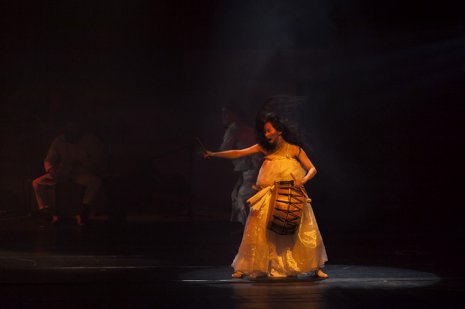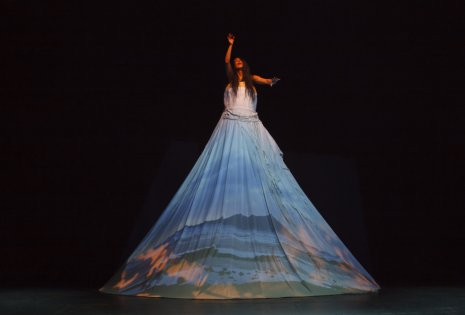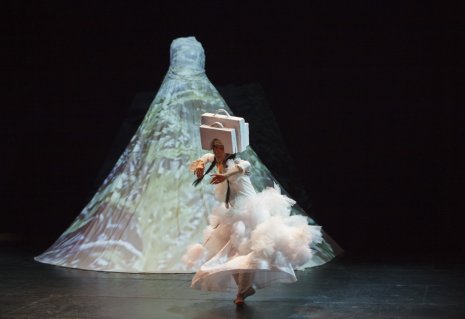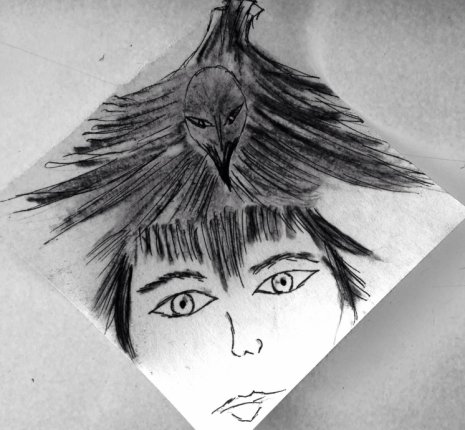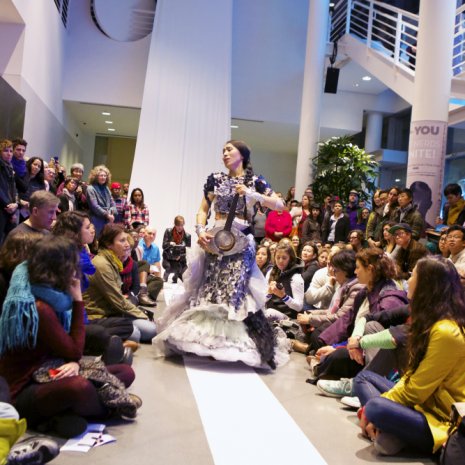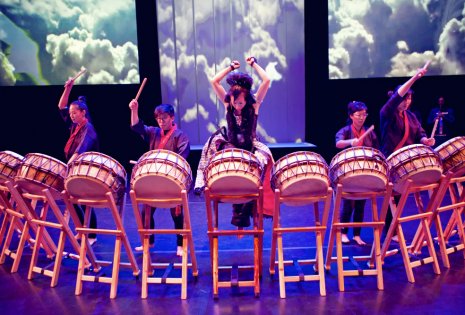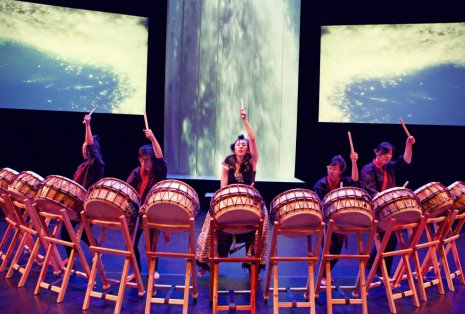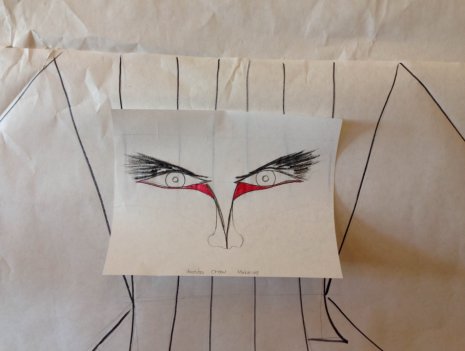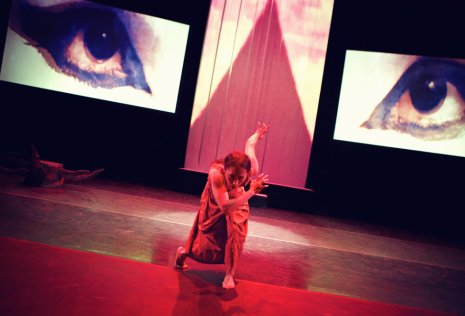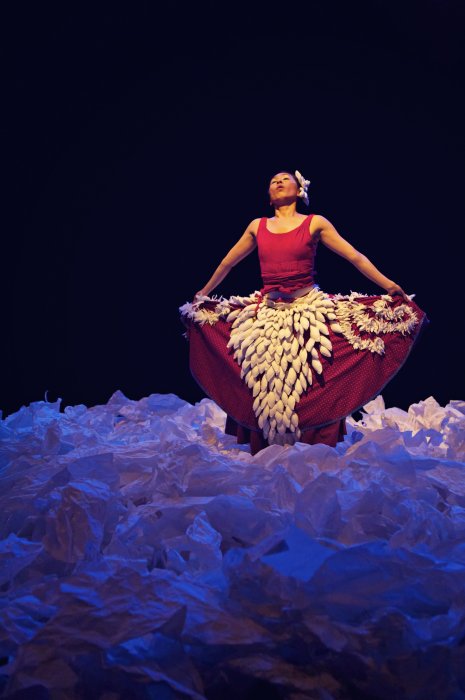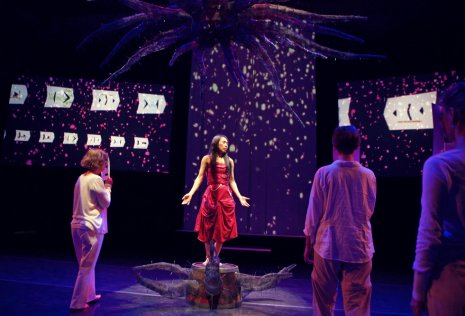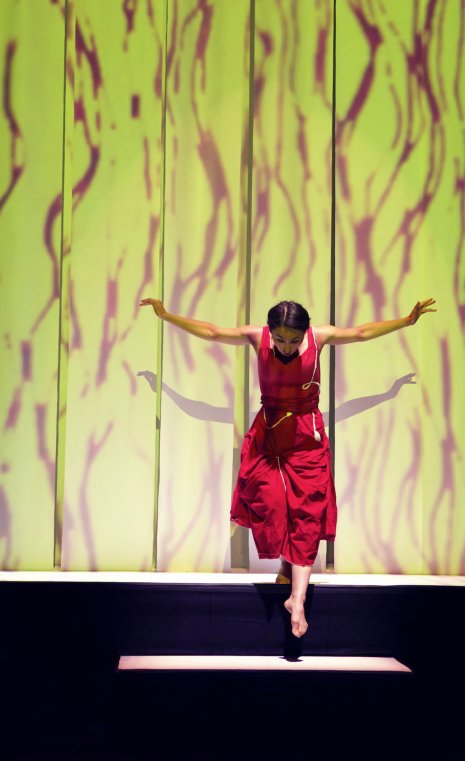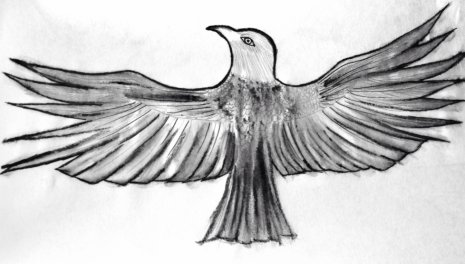Chapter Two
DL
Good question. I think I might keep doing it. But maybe when some traditional Korean performers see me they might think, what? They might be surprised. They might feel that what I’m doing is not in the tradition. But for me, I’m taking from the Korean tradition, the form, the foundation that I learned is an ancient form. With that understanding, when I put that out in the form of the performance, or ritual, I am really sincere. That’s the power of the process. To me it’s like ritual. It is beautiful to really, really respect people who are keeping the traditional forms and rituals. And, I think who I am is, ‘what’s happening now?’ In this way I think: what kind of tool is the most important to use? I am bringing technology into it. In the traditional way, in the rituals, there are no electronics, no computer, no technology; there are none of the sensors that we’re using; nothing. But I’m thinking about right now, this time, that ritual, and what kind of tool I can use for addressing the urgency, the stories. Then, you know, I can be free with it all. If I need a vibration sound, then I am using technology to respond to the time in which we live.
AF
Whatever tool’s available.
DL
Right. So that navigates me to open more possibilities, and more new resources such as working with different collaborators. That’s the part that I’m very excited about.
Every time is different but I follow the form of Korean rituals combined with modern approaches of movement, music, visuals, sets, costumes, installation and technology.
AF
So your collaborators now...I know you're working with Donald Swearingen again. Is there anyone else that is in line in the next year or two?
DL
Collaborating with Donald Swearingen is on going development of sound technology that we have been working together with wireless sensor play. Now, I’m looking for a visual artist who can collaborate along with this technology, particularly a video artist who integrates images and sensor play technology.
AF
Was this the piece that you did at Other Minds? Was that the first time that you worked with the idea?
DL
Yes, that's the one.
AF
Does the "Waterway" concept makes you think of video and projections, as opposed to staging or something like that?
DL
Exactly, the Waterway, and also connecting with the universe, the stars, because it's a community project. When I was thinking about community, it was like looking at the stars. We all have constellations: oh, this is Aquarius, this is Sagittarius, and that's Pisces. When you see the group of things, that's the community, and that's the name of the community, in the sky, that you can see.
And when you turn upside down from the sky, this is exactly what’s happening on earth. Each community has a very specific function. To me it's like mirroring, mirroring each other from here in our human world to there in universe. So how am I going to carry that image through visually? That’s why I want to work with a video artist, who can create that magic
AF
There's one thing that I feel like we’ve been touching on… with the work that we do here, at the Center for New Music, everything that we’re doing, I feel, is focused on giving people opportunities. That's what it's all about. And in a way, the thing that makes it about music is just that it's in the name. People come in with that conception: oh, it's a music place. I’ll come and do a music event. There's nothing specific that says it has to be about music here, but the desire of people to do a musical thing is obviously there, and the things that they ask for in space are all just in reaction to this practice of making music.
I've also been thinking a lot about jazz, and what we mean when we say ‘jazz;’ “we” meaning people in the San Francisco Bay Area. The training that you go through as a jazz musician is a tradition now. Maybe it wasn't 20 or 30 years ago, but the style of improvisation is something that you trained in. And, for me, I’m a bass player, so the style of playing bass, the different sort of roles for a bass, you get trained in that. It's like what you say about teaching drumming, you learn it precisely. You learn what you can and can't do, and how far out you can go.
But there's something in what you said about comparing people who hold their tradition against people who have some other way of creating. And that other way of creating, I’m really curious about that. Obviously the training is so essential to getting to that other place. But once you're in that other place of creating … watching you doing this gig, or that residency, or trying to find the right institution to work with, you fit and you don’t fit, for so many organizations, or stages, or spaces for performing.
How does that affect you? I mean, apart from the nuts and bolts of needing to write lots of grant applications, are there other ways that that affects the work that you do, or the kind of things that occupy your time as an artist?
DL
Right, well, you know, even this Herb Alpert Award, I was kind of surprised I got this. Because it's very specifically given to a composer. And when I see myself as an art-maker, I use all different media. That's one of things that I always question, where can I really fit? Where, and is, there a place for me? But one thing that is getting clearer is we do what we believe in and not think too much about where to fit. We just follow our path with full of compassion, commitment, joy and passion.
AF
It gets back to that notion of, like a shaman, having negative associations at home. Is there a way that you found that makes sense to tell people what it is you do?
DL
I’m getting clearer…but before, it was very confusing because there are certain places where you can play certain music, which is great. And many friends of mine who learned the traditional way, they're doing that. But for me, I know that I’m not for that and maybe I’m a little bit oddball, you know? I came here for doing something else.
I just follow whatever that is. Intuition? Destiny? I just follow that one, because if I just follow the other way, I know that it's not going to be who I am and what I want. It takes a little bit longer to get there, and the path is not smooth. It has a lot of bumps in little places. But I feel like I have to go through it.
AF
What are the bumps? Are they mostly logistics?
DL
Yeah, logistics and, you know, when people see the work samples and don’t get it. Or, they say, so what does she do? Because for me, thinking about what I am doing is more experience-oriented. Rather than something that will stay forever, 100 years of the beauty that you can see preserved for that long. For me it's the momentum of people experiencing it. So it has a different value in the aesthetic.
I understand that I don’t create something for the beauty. Beauty comes from reality and the ugly. Beauty comes from the pain, and beauty comes from the process of it. I really value that. Since people don’t see that yet as beauty, I have to keep doing it so people will someday go: Oh, that is beautiful. I didn't see the other side of it.
That's actually the ritual. When you see a Korean shamanic ritual or other countries rituals, it's frightening. It’s so wild and it's weird. The shamans say, ‘this is not a joke, I’m dealing with this person’s life and death, with a spirit.’
My performance has those kinds of elements in it. It's not about, ‘I have to make something beautiful.’ No…sometimes I have to cry, sometimes I have to just run around. Even though I know the structure and what we’re doing, inside of it, there is always an open space that allows things to happen. That's what jazz musicians do, I guess. You know, in improvising in music you listen, and find the moment to flow in and out that is why I am fan of Nina Simone.
That's why I felt strong connection with improvisation and experimental arts. It’s all about listening and how deeply you listen to the sound, music, space, player, performer, time, energy, feeling in certain way and understanding the depth of communication.
It’s all about communication. You’re waiting for the right moment, and you go with it, and sometimes, no, no, that's not right, and then you take it. That's the whole dynamic, and I love it. And doing this made me think, ‘I know that, that’s what shamans are doing.’
AF
That's one part of that practice.
DL
Yes, that’s the communication with the spirit that they're doing all the time. But what makes the shaman’s ritual so much richer to me is that when you see it, everything is there. Visual art is there, dance is there, music is there, food is there, and people are there. Everything is there. It's a rich total art, I always say: That's it. That's the art and life that people did from so long time ago.
AF
Your version of that.
DL
Yeah. That's the art that we began with, and we have to go back to do it again.
AF
Interesting. One thing we haven't talked about is place, and I know that you're focusing in more on site-specific work. Can you talk a little bit about your process for selecting places for ritual and what goes through your mind?
DL
For now, we have the space where we’re working this year. As an artist, I’m thinking a lot about the space itself and what it can be, how the different parts of the building and space can function and the ways that people can physically real feel the waterways without having to go out to the real water, to the ocean. I’m going to offer sing along rituals asking people to share the songs that remind them of their homes. They will be singing and sharing at their community space, and also a public space. I want people to experience an inner circle, and also an outer circle.
AF
You're looking for both.
DL
I’m looking for both. One performance will be for the community who are involved in the project, and another time will be for the regular audiences, so audiences also have the opportunity to sing their songs. Then later when community and audience members see the performance, they can connect more clearly and strongly. I’m varying those parts for participation, and creating some pieces that are rituals or activities, to be more inclusive.
AF
Interesting. It makes perfect sense for the types of projects you're doing, but it's quite different from lots of other artists who think about a site, like one site to realize a work, or how to impact a site. But it sounds like there are different parts of your process, and they each demand different things.
DL
Yes, it's a site-specific kind of performance, but it’s also a very different approach. They can come together, but how you begin with a site is: what is the main source that gives to this place? That guides how you work with it. But this project is centered on people’s stories. So some parts can be about a very specific place, but in other parts, it is not about a space in the site, it is in their bodies. How we bring our stories into our bodies and through our bodies.
want people to understand not only their stories, but also their story through their body. Their body as a home, and your hometown, your home, this place, your new home as home...and how you feel or see differently. I’m thinking both ways: the site as their body, and the site as environment.
AF
You mentioned audience members. You want people to observe, take part in, and feel the power of this process. How do you view that kind of participation for an audience member? Is it like an invitation to a future project, to go through something similar, or do you feel that watching other people go through the ritual has a certain power for them, too? In a related sense, if you're working with stories that are in a language that I don’t speak, is it important to you that I understand someone else’s story?
DL
Well, that's the beauty of people’s participation. In one piece, what people do is write. They write on pieces of colored paper, and what they write about is: what is one word, one thing that made you angry or hard in this country? They write about it then they tie it to a costume that I will wear. That’s the mediator’s role: you carry their anger. You wear their anger to confront and release.
AF
You embody it.
DL
Yes. So when they come, people know that their writing is in there. They're being involved in so many different ways. Sometimes they're physically doing it, but sometimes it’s their word that’s there; it's already activating them. And sometimes I will ask them to shout out something that they want to get out of their body’s system, out of everything. Some people do it, and some people will be witnesses. But, very specifically, with the words and being witness, this part is actually their part. I’m just carrying it. Someone writes about it, and I’ll deal with it. But they need to be there as a participant and witness.
AF
One last question: I’ve had a lot of interesting conversations with people, particularly Asian-Americans, about their distance from that immigration story, and how the experience of a first-generation immigrant is a particular thing, and then a second generation can often mean a particular thing, because it's more about growing up rooted here while having family that's rooted from elsewhere. So there's that disconnection that tends to form a lot of identity.
What I anticipate now, thinking about the next generation and as these stories do or do not get passed down, there's a kind of ignorance born of just being young. The story gets lost in some way. Or the story is failing to reach myth. How do you think of this project in relation to that, considering how far back you're trying to go? Do you see that as essentially preserving these stories in the way that you preserve a tradition, or do you feel that it's a natural progression of things, for the stories to exist but inevitably run their course?
DL
I’ve thought about that a lot. I’m first generation, but I have many first, 1.5 and second generation friends. So whenever I see younger folks, I feel it’s so important for them to hear those stories. I was very sad that no one told me about my family story. So, now I’m asking my mom and my dad about my grandparents and great-great grandparents. That kind of understanding about why I am like this can bring a deep understanding. I feel like this is important as an educational tool. We need to know, in order to become free. If we don’t know, we’re just constantly ignorant.
It feels important, even if it’s not easy to share, to share just a little bit, just open up a little door. We don’t need to open all the doors and go in there, but just open it a little bit. And that's people’s choice, to go in, to research more, or not. But at least we have to give that little bit encouragement, so that these journeys keep going, so it's not about cutting off.
There are so many cut off things. I have heard from so many people that they have a hard time finding their ancestors. They felt it was important, but they couldn’t get the information from their parents because they have already passed away.
AF
Yes. Thinking about how far back the stories go for other people’s families, and if as you have said, we appreciate that America was founded on these stories from the very beginning, it should be applicable to everybody. But there's some breaking point, when someone starts to feel like they're assimilated, or they're part of the majority. That's what we interrogate when we ask what it means to be white in America. I’m fascinated by that gray area between the time when we can count the generations of where you came from, up to the moment of when it’s so many generations, or the stories have been lost, and so the awareness is just gone.
DL
Yeah, it's getting complicated, but at the same time, it's very simple. Just ask, right? But that's hard, you know, to take that action to ask. It took me a long time, and also there is the concept of timing, right timing, too.
AF
Right, for both sides.
DL
Right, both sides. For me and also for my parents, and I totally missed all the things from my grandparents. I’m so sad I couldn’t really ask those questions, because I wasn’t ready to ask or even to know what to ask. So it’s about your inner growth and that kind of time that you need, and also when the time comes, not hesitating, going for it, to ask about, and research about it.
I feel like that's all my work, my creative work process is research. I do a lot of research on what makes me curious. I start researching all the different parts. Each one, each different part, each chapter of the story has so much information. In MAGO, the first chapter was about the goddess; I researched Mago, the creator goddess in the Korean shamanic tradition and mythology. The next chapter was about Jeju and my grandparents. Another chapter is about how past lives and present come together, so all the research about karma. (Laughs). And another one is about Jeju Island, the history of our massacre, all about how and why massacres happened and current issues of building U.S and Korean Naval Base in Jeju, how these two issues are connected. And another one is the invited ritual where I came out as a crow for a very specific reason; you know Jeju has lots of crows there especially in massacre sites. So I researched all about crows. Each chapter has all different categories of resources. That’s the creative process. And when you see the stories or all the information, you hear the sound, you hear the music and stories through myth through past, present and future…
AF
That's a very composer-ly thing to say.
DL
(Laughs) Right? It's like you hear the music, and sometimes you just record what you hear, and sometimes you write, or sometimes you draw. That's how I work on the side of making music. It’s very interesting when you see clearly with that part, that chapter, right away you can see what’s happening. You can hear the sound and stories.
AF
It makes music for you.
DL
Sometimes it comes like this (Snaps fingers twice). Oh yeah, like this, this is it. For example, when I composed the music for MAGO, one piece was about my grandmother who was a diver so when I heard a free diver’s breath after their diving in Jeju, it is called “Soombisori,” then right away that became the motif of the song. It comes very quickly. However, sometimes nothing is coming. You have to wait and research and study more…then later it comes.
AF
Right, that's almost like a mystical process. I’ll be fascinated to see how that research project maps onto other people’s stories, especially dealing with so many all at once; it's going to have a different kind of power, I think.
DL
Right, yeah, I’m curious, too.
AF
Anything else you want to say, on the record?
DL
Well, for me, why this is important, why I am doing art, for me, is connected with life and healing. It’s how art has the potential to open up something that you never thought that you could do. I have a strong feeling about art, that art has a power, a strength in it. The empowerment that it has -- that's why people are so creative. Each person is very creative. We don’t use it enough. In that way, with art, if we create those parts that are on the side of something hopeful, and something encouraging, I feel like it's really important to keep doing it. Through the music, and through the dance and visual, and whatever tool is right for that.
AF
For anyone to participate in.
DL
Anyone. I feel like that's why doing this art is becoming more significant for me, and even thinking about having an organization. That way I could share this performance more widely, and also create an education program where people can learn what they can do, so they can support others.
AF
That brings to mind a couple of things. There’s a whole category of community arts that’s really being redefined right now. For a long time it was sort of code for access to the arts for people who couldn't otherwise afford it. But I think it's starting to mean something different now, something closer to what you are saying.
I've also seen a couple other artists who do view the work as healing. There was one project over the last couple of years, called the ‘Love Balm Project.’ It was about mothers who lost their sons to violence, largely for African-American communities. I know that it was really powerful, and it came out from Arielle Brown, she’s a theater artist. There are other artists out there who have a similar method of working, but I think you're the only one I've heard of so far that comes from a music background; it's unique. But I do think there are allies for you out there.
DL
Yeah, that's really great. And we need more.
AF
Well there are so many people who need that opportunity, the creative opportunity. And a meaningful one, not just another failed attempt at learning to play the guitar or something like that.
DL
It's good, playing guitar or whatever instrument you are learning; learning is good. How you learn and play and relate to your life and joy, it is not just building your muscle capacity and skills.
AF
It’s going in a gym, right? How many people join a gym in January, and then they don’t go, because going to the gym’s not very fun. So why would you do it? But maybe if you find a better reason...
DL
Yes, it requires tremendous of diligence. And commitment. Sometimes that's hard. That's the hardest part; maybe that's why people are not going to the gym, because they are running but not understanding the space of breathing. It is all a form of art.
It’s fascinating to listen to people talk about what they're interested in. I love communicating with people because I want to understand more closely, and more deeply, so I can discover whether I can support them or not. And if I cannot, I can find someone who can support them. But many times I hear: I don't know what to do. I really don’t know...I don't know why I’m even...?
AF
Why am I here anymore?
DL
Or why I’m right here. Then, like, wow, okay, we need to bring all those questions back to the body.
AF
Mm-hmm, and force action in some way, right?
DL
Yeah. That's…that's why I love and respect Anna Halprin so much. It's all about body. Go back to the body. If we connect with our body, then we are connected. It’s really about self-awareness. I also respect David Harrington, too, because he was the person that gave me a possibility.
AF
How do you mean?
DL
You know, “everything is possible.” I’d never heard a famous musician say that. He was like: You just bring the music, we will play for you. That was the moment that dream came true. Because I didn't know that I was going to be a composer.
Those kinds of moments of…tapping the stone? You can see this stone that I found, you see your future through that, your potential through it. I respect those people who encouraged me. There are so many musicians and artists who inspired me. I have gotten a lot of support to get here, to be who I am.
AF
Well, that's great. I think, especially this particular award, it’s all about more encouragement to keep going on the path to that vision.
DL
Yeah, and I appreciate that it's about things that, if you believe in yourself a little bit more, you can do it. To me that kind of encouragement is really huge. Another step, okay, I’m going to keep doing, and not just keep doing it, I’m going to develop it. I’m going to develop work around it, and gradually grow with it so I can share more and do something more meaningful.
AF
Wonderful. Thank you for making time. It was great to talk with you.
DL
Thank you for doing this too!
*Adam Fong is the co-founder and executive director of the Center for New Music, and an active composer, performer and producer. Fong earned Master's degrees in Music Composition from California Institute of the Arts, and in English from Stanford University. He also co-founded Emerging Arts Professionals, is a member of the Emerging Leader Council of Americans for the Arts, and is a frequent advisor to a broad community of artists, arts leaders, and arts organizations.


